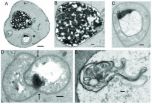(Press-News.org) For many people with gastroesophageal reflux disease or GERD, acid reflux drugs are the answer to their woes, curbing the chronic heartburn and regurgitation of food or sour liquid characteristic of the disorder. But when it comes to Barrett's esophagus, a condition commonly found in people with GERD, acid control may be less important than beating back another bodily fluid – bile.
A new study published in the Annals of Surgery shows that bile – a digestive fluid that leaks backwards from the stomach into the esophagus along with acid in patients with GERD – plays a critical and previously unrecognized role in the development of Barrett's esophagus. Study authors say the findings provide new avenues for the prevention and treatment of the condition, which is the only known cause of a rare but often deadly type of cancer called esophageal adenocarcinoma.
"Our ultimate goal is to understand the biology of Barrett's so that we may find drugs that inhibit or reverse the condition, thus preventing cancer," said lead study author Jeffrey H. Peters, M.D., an internationally recognized expert in surgery of the esophagus and stomach and the Seymour I. Schwartz Professor and Chair of the Department of Surgery at the University of Rochester Medical Center. "The finding that bile is important is key because current drug therapies for GERD focus largely on acid control."
Acid-reducing drugs called proton pump inhibitors or PPIs are some of the most popular and best-selling drugs in America according to IMS Health, an organization that tracks pharmacy data. While the drugs do a great job of masking GERD symptoms by neutralizing stomach acid, Peters' research suggests they may not be the answer when it comes to blocking Barrett's esophagus. Other research even indicates that such drugs may actually make patients more prone to developing Barrett's.
Normally, our esophagus – the muscular tube connecting the mouth to the stomach – is lined with skin-like tissue. But, in people with Barrett's, it's replaced by tissue that more closely resembles the lining of our intestine, which is smooth and red. Peters' team found that bile that washes up from the stomach into the esophagus shuts off genes responsible for the normal, skin-like lining of the organ, and turns on genes that produce the intestine-like lining that is the hallmark of Barrett's.
They discovered that acid, on the other hand, didn't largely influence the change from one cell type to another.
While previous research established that reflux components encouraged the development of intestinal tissue in the esophagus that alone was never enough to produce the changes that led to Barrett's.
"The main leap this study makes is that normal esophageal cell growth must be turned off and intestinal cell growth must be turned on in order for the disease to take hold," noted Peters, who is president elect of the International Society of Diseases of the Esophagus. "We found that bile promotes both processes."
Study author Tony E. Godfrey, Ph.D., says the findings make perfectly good sense. "In people with Barrett's, the inside of the esophagus looks like the inside of the intestine. Bile is normally found in the intestinal environment, so when stem cells in the esophagus are exposed to bile that is what they change to."
According to Godfrey, a research associate professor in the Department of Surgery, the lining of the esophagus is shed and replaced on a regular basis, so blocking bile's ability to thwart the production of normal esophageal cells may be one potential treatment strategy. Currently, the only way to stop all reflux components, including bile, is to surgically reconstruct the faulty barrier between the esophagus and the stomach.
The team performed the first-ever analysis of all genes that are turned on and off in normal esophageal cells exposed chronically to bile or acid. The findings were tested and confirmed in human samples of normal esophageal cells and in cells from patients with Barrett's esophagus.
The research is especially exciting for Peters, who regularly treats patients with Barrett's as well as patients who develop esophageal adenocarcinoma. Though uncommon, Peters says it's one of the fastest-rising cancers in the world, likely due to the increase in obesity, which triggers reflux disease and Barrett's. Unfortunately, it is an extremely aggressive cancer that is usually caught at a very late stage, so prevention strategies are greatly needed.
###The Department of Surgery at the Medical Center funded the study. In addition to Peters – who serves as the associate editor of the Annals of Surgery – and Godfrey, Marie Reveiller, Ph.D., Sayak Ghatak, Liana Toia, Mary D'Souza, Ph.D., Zhongren Zhou, M.D., Ph.D., and Santhoshi Bandla, Ph.D., from the University of Rochester contributed to the research. Scientists from the Ontario Institute for Cancer Research in Toronto and the Pittsburgh Cancer Institute at the University of Pittsburgh also participated in the study.
Bile – not acid – is bad guy in triggering precancerous condition associated with reflux disease
2012-04-25
ELSE PRESS RELEASES FROM THIS DATE:
Improving on the amazing: Ames Laboratory scientists seek new conductors for metamaterials
2012-04-25
AMES, Iowa -- Scientists at the U.S. Department of Energy's Ames Laboratory have designed a method to evaluate different conductors for use in metamaterial structures, which are engineered to exhibit properties not possible in natural materials. The work was reported this month in Nature Photonics.
Cloaking devices that hide planes from RADAR, microscopes that can see inside a single cell, and miniature antennae that measure only a few millimeters all sound like parts of a science fiction movie. But, within the span of the decade since they began their work, Ames Laboratory ...
Binge eating may lead to addiction-like behaviors
2012-04-25
HERSHEY, Pa. -- A history of binge eating -- consuming large amounts of food in a short period of time -- may make an individual more likely to show other addiction-like behaviors, including substance abuse, according to Penn State College of Medicine researchers. In the short term, this finding may shed light on the factors that promote substance abuse, addiction, and relapse. In the long term, may help clinicians treat individuals suffering from this devastating disease.
"Drug addiction persists as a major problem in the United States," said Patricia Sue Grigson, Ph.D., ...
Yeast cell reaction to Zoloft suggests alternative cause, drug target for depression
2012-04-25
Princeton University researchers have observed a self-degradation response to the antidepressant Zoloft in yeast cells that could help provide new answers to lingering questions among scientists about how antidepressants work, as well as support the idea that depression is not solely linked to the neurotransmitter serotonin.
In findings published in the journal PLoS ONE, researchers based in the lab of Ethan Perlstein, an associate research scholar in Princeton's Lewis-Sigler Institute for Integrative Genomics and senior lecturer in molecular biology, report that sertraline ...
Pod corn develops leaves in the inflorescences
2012-04-25
This press release is available in German.
In a variant of maize known as pod corn, or tunicate maize, the maize kernels on the cob are not 'naked' but covered by long membranous husks known as glumes. According to scientists from the Max Planck Institute for Plant Breeding Research in Cologne and Friedrich Schiller University in Jena, this variant arises from the activity of a leaf gene in the maize cob that is not usually active there. Thus, pod corn is not a wild ancestor of maize, but a mutant that forms leaves in the wrong place.
Pod corn has a spectacular ...
Rhode Island Hospital researcher: Broadening bipolar disorder criteria is a bad idea
2012-04-25
PROVIDENCE, R.I. – A Rhode Island Hospital psychiatrist and researcher explains the negative impact of broadening the diagnostic criteria for bipolar disorder in the upcoming Diagnostic and Statistical Manual of Mental Disorders, Fifth Edition (DSM-5). In a newly published commentary in the Journal of Clinical Psychiatry, Mark Zimmerman, M.D., explains that lowering the diagnostic threshold for bipolar disorder will likely do more harm than good for patients.
As the debate continues over the revisions to DSM-IV, Zimmerman, the director of outpatient psychiatry at Rhode ...
Dietary changes help some children with ADHD
2012-04-25
Together with child and adolescent psychiatrists, researchers from the University of Copenhagen have just completed an extensive report which reviews the studies which have been done so far on the significance of diet for children and young people with ADHD. The report shows that there are potential benefits in changing the diets of children with ADHD, but that key knowledge in the area is still lacking.
The comprehensive report covers the scientific literature on the significance of diet for children with ADHD:
"Our conclusion is that more research is required in the ...
CAM therapy combined with conventional medical care may improve treatment of lower back pain
2012-04-25
New Rochelle, NY, April 23, 2012— Nearly 8 of 10 Americans will experience lower back pain at some time in their lives. Persistent low back pain is a common, incapacitating, costly, and difficult to treat condition. Many patients might benefit significantly from an individualized, multidisciplinary, team-based model of care that includes access to licensed complementary care practitioners (e.g., chiropractors, massage therapists, and acupuncturists) in addition to conventional care providers, as demonstrated in a study published in The Journal of Alternative and Complementary ...
On-the-job deaths steady in Michigan; Number of burn injuries underreported
2012-04-25
EAST LANSING, Mich. — The rate of workplace deaths in Michigan remained steady in 2011, as 141 workers died on the job compared with 145 in 2010, according to an annual report from Michigan State University.
The construction industry had the most deaths at 24, while the agriculture industry had the second most at 22, according to the Michigan Fatality Assessment and Control Evaluation program, or MIFACE.
The program – administered by MSU's Division of Occupational and Environmental Medicine, part of the College of Human Medicine – investigates work-related deaths and ...
'Junk DNA' can sense viral infection
2012-04-25
Once considered unimportant "junk DNA," scientists have learned that non-coding RNA (ncRNA) — RNA molecules that do not translate into proteins — play a crucial role in cellular function. Mutations in ncRNA are associated with a number of conditions, such as cancer, autism, and Alzheimer's disease.
Now, through the use of "deep sequencing," a technology used to sequence the genetic materials of the human genome, Dr. Noam Shomron of Tel Aviv University's Sackler Faculty of Medicine has discovered that when infected with a virus, ncRNA gives off biological signals that ...
Carrentals.co.uk Reports Surge in Car Hire Bookings Ahead of 2012 Olympics
2012-04-25
Demand for car hire around the 2012 Olympic Games has surged recently according to leading online car hire comparator Carrentals.co.uk. The website is advising people to book rentals well in advance if they want to get plenty of choice and availability of cars this coming summer.
Carrentals.co.uk reports that rental bookings for between 20 July and 12 August are up by around four times on the same period in 2011, with 40% of total bookings around the Olympics set for collection at Gatwick or Heathrow airport.
July 20 and 21 will see the most cars being collected as ...



